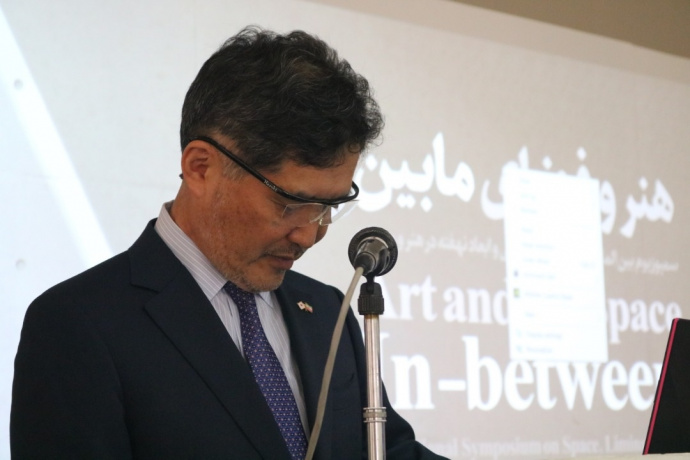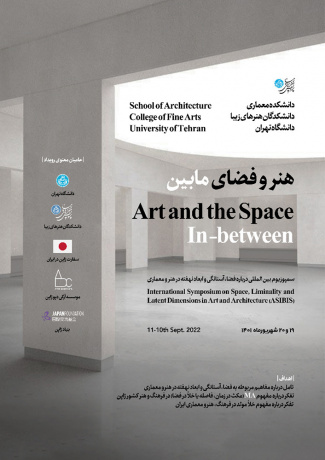International Symposium on Art and the Space in Between held at UT College of Fine Arts
On the 10th of September, 2022, the opening ceremony of the International Symposium on Art and the Space in Between was held at the venue of College of Fine Arts, University of Tehran in the presence of eminent Iranian and Japanese professors and students, Mr. Aikawa Kazutoshi Ambassador of Japan, Prof. Hamed Mazaherian, Dean of College of Fine Arts , Prof. Eslami, Deputy Dean for Academic Affairs , School of Archiecture and Abdolmajid Eskandari, Director General of Office of International Relations.
In the opening ceremony, Director General, Office of International Relations, Ambassador of Japan and one of the Japanese professors presented their speeches and the program continued with discussions through professional panels.
About the Symposium
The space in between or Liminal space reflects hidden dimensions of art and architecture. It makes possible the threshold and the entrance to the inner world and makes the intermediate space between the events of the outside world and the ongoing life in the inner world. The inner world, like a paradise and heaven or a holy place, hides its beautiful treasure and reveals it behind different layers of movement, gradually and with the transition from outside to inside. The intermediate space forms the border between the earth and the sky and is the place of presence of light and shadow, darkness and brightness, color and brilliance. Veiling and camouflage, ambiguity and uncertainty, empty and void and different layers of transition from outside to inside are words that define the space in between. Many elements and components of Iranian art and architecture are formed at the points of transition from one space to another and among the elements and components in accordance with the dignity and value of the space and give it a different meaning. The distance in the space in between is a place to understand the elements that create the space, and throughout the history and culture of Iran, it has given meaning to the content of art and architecture in different ways.
In a comparative study between this concept and the ideas that shape space in the Eastern world, we come across a similar concept in Japanese art and architecture. 間 or "Ma" in Japanese language is like a ray of light that shines through a door, it reflects the idea of the middle and empty space between inside and outside. 間 or "Ma", which is used with the meaning of both time and space, gives a distinct aesthetic value to the empty space between lines, elements, sections and words. "Ma" is a break in time and a gap and void in space, which is as important as space itself in the overall composition. The empty space is full of possibilities that have not been used yet and has untold secrets. Yet with the concept of intermediate space, Japanese architecture wrap its interior among different layers of transparent component and connecting corridors and form another aspect on interior/exterior, movement and pause, activity and calmness, in relation with light and shadow.
Considering the importance and validity of the concept of liminality in Iranian culture and 間 or "Ma" in the thought of Eastern aesthetics and shaping different concepts in art and architecture, the International Symposium on Art and the Space in Between is held on 19th and 20th of Shahrivar, 10 and 11 September, at Tehran University, College of Fine Arts. The objectives of this symposium are:
Thinking about the concepts related to space, liminality and hidden dimensions in art and architecture
Thinking about the concept of 間 or "Ma", a pause in time or distance and void in space in Japanese culture and art
Thinking about the concept of distance and productive space in Iranian culture, art and architecture
This symposium with the presence of various professors from Iran and Japan from various fields related to art and architecture in four different panels pursues the goals of the symposium as follows:
Panel 1: Liminality and 間 or "Ma" in architecture and space
Panel 2: Liminality and 間 or "Ma" " in intellectual history
Panel 3: Liminality and 間 or "Ma": conceptualization and terminology
Panel 4: Liminality and 間 or "Ma": in media, performance and ritual
MA Concept
More than 40 years ago, Arata Isozaki, Pritzker Prize winning architect in Japan in 2019, has raised this idea of MA to the Western world, making use of an exhibition entitled “間 MA – Space / Time in Japan” held in Paris. The term of MA was used to explain the uniqueness and peculiarity of Japanese architecture and art, contrasted with the Western idea of space, which has clear notion of border and hierarchy. His approach did not come only from architecture itself, but also from the profound reading of Eastern philosophy and literature, which represent the sense of ambiguity and uncertainty between confronting spaces and objects such as outside/inside or void/solid. The effort of Isozaki sowed the seeds for the new dimension of understanding architecture and space, which is liberated from the restraints of classical logic of the Western-based thinking. Eastern architecture, in a much broader way, could be interpreted with such a loose concept as in-between or MA (間). The symposium is a fruit of joint discussion between Iranian and Japanese specialists on architecture, art, literature and music for several years. In view of holding an Exhibition MA and the publication of the Encyclopedia next year, experts and professionals from two corners of the East gather in Tehran in a form of wise men forum.





Your Comment :